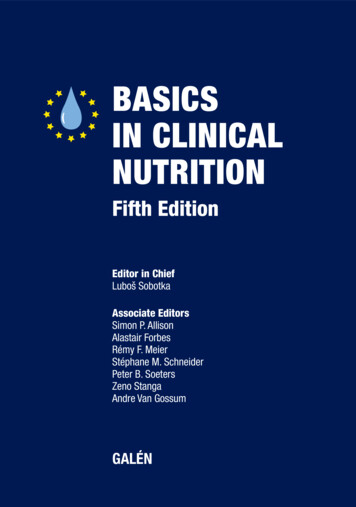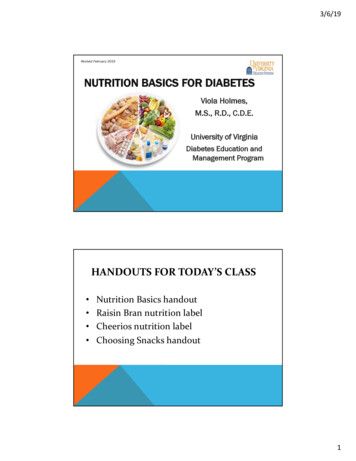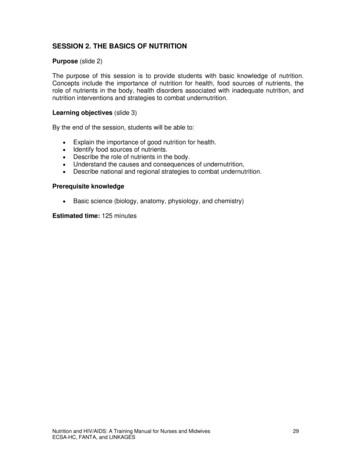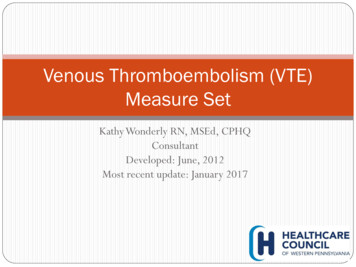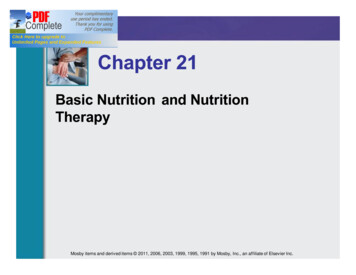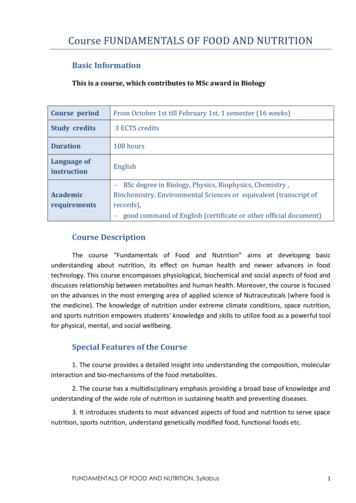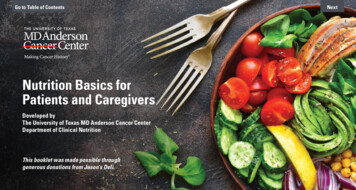
Transcription
Go to Table of ContentsNutrition Basics forPatients and CaregiversDeveloped byThe University of Texas MD Anderson Cancer CenterDepartment of Clinical NutritionThis booklet was made possible throughgenerous donations from Jason’s Deli.Next
Go to Table of ContentsNutrition Basics forPatients and CaregiversDeveloped byThe University of Texas MD Anderson Cancer CenterDepartment of Clinical NutritionThis booklet was made possible throughgenerous donations from Jason’s Deli.BackNext
BackGo to Table of ContentsTable of ContentsNextTO THE PATIENT AND CAREGIVERImportance of Nutrition. 5Managing Side Effects. 27FOOD AND NUTRIENTSManaging Blood GlucoseDuring Steroid Treatment. 29Strengthening the Immune System. 7Introduction to Nutrition Support. 31Power of Plants.11Dietary Supplements.33Carbohydrates. 13Importance of Activity. 35Protein Sources. 17Cancer Related Fatigue. 39Fats. 19Food Safety Tips. 41Hydration.23Grocery Shopping Tips. 45Buying Organic?. 25Recipes. 47Resources. 61Nutrition Basics for Patients and Caregivers Department of Clinical Nutrition3
Go to Table of ContentsBackNext
Go to Table of ContentsBackNextImportance of NutritionNutrition plays a role in cancer at all stages – prevention or riskreduction, treatment and post-treatment. The American Cancer Society(ACS) and the American Institute of Cancer Research (AICR) advise aplant based diet. A plant based, whole food diet emphasizes vegetables,fruits, whole grains, legumes, nuts and seeds. Lean protein such as dairy,meats, poultry, seafood and eggs are included.Cancer treatments include chemotherapy, radiation therapy, surgery,immunotherapy, and T-cell therapy. Nutrition plays a role in overall cancertreatment and healing.Nutrition Basics for Patients and Caregivers Importance of Nutrition5
Go to Table of ContentsReceiving adequate nutrition provides the body energyto sustain itself through treatment. Nutrition also helpsto manage treatment side-effects (such as nausea andfatigue) and aides in recovery after treatment.Registered dietitians (RDs) are available to assist youthroughout the treatment and post-treatment processin addressing nutrition questions and concerns. Thisbooklet answers common nutrition questions; however,it does not substitute for an evaluation by a registereddietitian to provide a plan of care designed specificallyfor you.Nutrition Basics for Patients and Caregivers Importance of NutritionBackNextThe Department of Clinical Nutrition strives to promotecomprehensive nutrition care for our patients. RDsprovide education, assessment and counseling topatients and their care givers and work closely withyour health care team to provide specific nutritionsupport for your individual needs. Many of our RDs areBoard Certified Specialists in Oncology Nutrition orCertified Nutrition Support Clinicians.If you would like to see a dietitian pleaseask your medical team for a consult,send a message through MyChart, or call theDepartment of Clinical Nutrition at 713-563-5167.6
Go to Table of ContentsBackNextStrengthening the Immune SystemAdequate protein and energy (calorie) intake as well as a healthy weightare essential to support the immune system. Both undernutrition andobesity affect the immune system negatively.There are multiple vitamins, minerals, and components of food that areessential to support the immune system mentioned throughout this guide. Vitamins C, D and E Carotenoids such as beta carotene(which the body can convert to vitamin A) PhytochemicalsNutrition Basics for Patients and Caregivers Strengthening the Immune System7
BackGo to Table of Contents Minerals selenium, copper and ironOmega-3 fatsFiber (prebiotics)Spices turmeric, garlic and cinnamonImbalances in the diet and inadequate intake of thesenutrients negatively impact the immune system.PhytochemicalsThere are thousands of phytochemicals in a wholefood plant based diet. These powerful compounds havemany disease-fighting properties including working asantioxidants, strengthening the immune system andfighting viruses.NextFor more information see pages 11, 12, 48, 52, 58 in thisbooklet or visit AICR.org.Prebiotics and ProbioticsA healthy Gut Microbiome includes beneficial bacteriawhich helps strengthen the immune system. Foodswhich contain Prebiotics and Probiotics act as“fertilizer” to healthy organisms in your gut.PREBIOTICS are fermentable dietary fibers thatencourage the growth of good bacteria in your gut.Examples of foods containing prebiotic fiber include:chicory root (inulin), ground flaxseed, legumes,onions, garlic, oats, barley, bananas, apples with skin,asparagus, tomatoes.Nutrition Basics for Patients and Caregivers Strengthening the Immune System8
BackGo to Table of ContentsPROBIOTICS are live bacteria that can be found inyogurt and other fermented foods. There are hundredsof probiotic species available. Which of thesespecies are best for the average healthy person isstill unknown. Speak to your medical provider beforetaking any supplements for probiotics. Foods are best.Examples of cultured foods that contain probioticorganisms include: yogurt, kefir, buttermilk and otherfermented products like kimchee and sauerkraut.For more information see pages 14, 15, 52, 54 in thisbooklet or visit AICR.org.NextOmega-3 Fatty AcidsThe essential polyunsaturated fatty acids called“Omega-3 fats” have biological effects such asregulating the inflammatory response and cell growth.Examples of foods that are rich in Omega-3 fatty acidsinclude: cold water fish (ie. salmon), ground flaxseed,walnuts, flaxseed, canola or walnut oil, dark leafygreen vegetables, grass fed meat, chicken or eggs fromchickens that are grass fed.For more information see pages 20, 50, in this bookletor visit AICR.org.Nutrition Basics for Patients and Caregivers Strengthening the Immune System9
Go to Table of ContentsNutrition Basics for Patients and Caregivers Strengthening the Immune SystemBackNext10
Go to Table of ContentsBackNextPower of PlantsPlant foods are rich in phytochemicals that can help protect againstcancer. Phytochemicals are naturally occurring compounds in plants.When eaten, they have a wide range of health benefits. The AmericanInstitute for Cancer Research (AICR) recommends that at least two-thirdsof your plate be filled with plant-based foods. Plant-based foods includevegetables, legumes, whole grains, nuts, tea and spices. Choose bold,colorful and strong flavored vegetables and fruits for the best sourcesof phytochemicals.Nutrition Basics for Patients and Caregivers Power of Plants11
BackGo to Table of ContentsPhytochemicals have been found to: Stimulate the immune system Block production of carcinogens Reduce inflammation that can trigger cancergrowth Prevent DNA damage and assist with DNA repair Reduce oxidative damage to cells that can inducecancer Slow cancer cell growth and reduce reproductionof damaged cells Help regulate hormonesNutrition Basics for Patients and Caregivers Power of PlantsNextExamples of phytochemicals include: Beta carotene: pumpkin, sweet potatoes, carrots,cantaloupe, broccoli, spinach, kale, collard greens Lycopene: red bell peppers, tomato/tomatoproducts, watermelon Lutein: broccoli, Brussels sprouts, artichokes, kale Polyphenols: green tea, grapes, wine, whole grains,peanuts Anthocyanidins: blueberries, blackberries, plums,cranberries, strawberries, red onions, radishes Isoflavones: soy beans and soy products (tofu,edamame, soy milk, etc.)12
Go to Table of ContentsBackNextCarbohydratesCarbohydrate is one of the main building blocks of a healthy diet, alongwith protein and fat. It provides a source of energy for your body andbrain. There are two special components to pay attention to whenchoosing carbohydrates: fiber and sugar.Nutrition Basics for Patients and Caregivers Carbohydrates13
BackGo to Table of ContentsFiberVegetables, fruits, legumes and whole grains are agreat source of fiber, which aids in digestive healthand prevention of certain cancers. Fiber can also helpmaintain normal blood sugar levels as well as a healthyweight. During some cancer treatments, fiber type oramount may need to be adjusted. Talk to your doctor ordietitian if you have questions.Nutrition Basics for Patients and Caregivers CarbohydratesNextWhole grains are a good source of energy. They alsoprovide a variety of B vitamins, manganese, seleniumand phytochemicals. Try these high-fiber grains fortheir unique taste and texture.AmaranthFarroBarleyBrown RiceBulgurKashaMilletWhole wheatQuinoa (seedof a grain)SorghumTeffOats14
Go to Table of ContentsBackNextAim to include whole grains in each meal as part of aplant-based diet. If you do not already include wholegrains, start by adding them in small amounts: Add a tablespoon of oats to yogurt in the morning Try a sandwich made with whole wheat breadinstead of white bread Substitute half of your rice with brown rice if youare used to eating white riceMake it fun and try a new grain each week. See theRecipes section of this booklet for tasty recipes madewith whole grains.Nutrition Basics for Patients and Caregivers Carbohydrates15
Go to Table of ContentsBackNextSugarSugar is the simplest form of carbohydrate. It existsnaturally in whole foods such as fruits. It is also anadded source of calories such as those found in sweets(cookies, cakes, ice cream, sodas, etc). One of manyconcerns related to nutrition and cancer is whethersugar increases cancer risk or promotes the growthof existing cancers. More research is needed to fullyunderstand this topic. You cannot “starve” cancer cellswithout starving healthy cells. Therefore, it is best tofollow a well-balanced diet that includes carbohydratesfrom whole foods while minimizing intake of foods thatcontain added sugars.Nutrition Basics for Patients and Caregivers Carbohydrates16
Go to Table of ContentsBackNextProtein SourcesA well balanced diet must include lean proteins. Protein is essential forgrowth, repairing body tissues and maintaining a healthy immune system.As outlined by AICR guidelines, you should fill no more than one-third ofyour plate with fish, poultry, meat, eggs or dairy foods. At least one daya week, try eating plant based proteins, such as beans, lentils, or tofu/soybeans, instead of animal proteins. Your body will benefit from theadditional fiber as well.According to research, diets high in red meat and processed meatsincreases risk for colorectal cancer. Limit intake of red meat, such aspork, lamb or beef, to about 18 ounces (oz) or less a week.Nutrition Basics for Patients and Caregivers Protein Sources17
Go to Table of ContentsAvoid processed meats, such as deli meats, sausages,salami, pepperoni, bacon, hot dogs, corned beef,bologna or ham, entirely. Fresh foods with minimaladditives are recommended.Minimize the use of high temperature cooking methodssuch as direct contact with flames when barbecuing.This will reduce exposure to potentially harmfulcompounds that may contribute to cancer risk.SoySoy is a plant-based protein that contains fiber,potassium, magnesium and other essential nutrients.Soy foods include edamame, soy milk, tofu, and tempeh(a vegetarian replacement for meat).Nutrition Basics for Patients and Caregivers Protein SourcesBackNextPatients sometimes question if soy may increasethe risk for certain types of cancer. Soy containscompounds called isoflavones, which can act likeestrogen in the body. The American Cancer Societyrecommends that whole food sources of soy are safeto consume in moderate amounts, even for most breastcancer patients. Typically 1-3 servings of a soy-basedfood is safe to have as part of a healthy balanced diet.One serving would be 1 cup of soy milk, 1/2 cup ofedamame or 1/3 cup of tofu. If you are still concernedabout including soy in your diet, ask for a consult withyour dietitian for more information.18
Go to Table of ContentsBackNextFatsFats can be broken down into three main types – unsaturated, saturatedand trans fats. Fat is essential for our bodies as it provides energy andcan promote good health through their anti-inflammatory properties.They also help the body absorb essential fat soluble vitamins. Theseinclude vitamins A, D, E and K.Not all fats are created equal and must be consumed in moderation toavoid unwanted weight gain, since all fats and oils are high in calories(including healthier fats).Nutrition Basics for Patients and Caregivers Fats19
Go to Table of ContentsUnsaturated FatsUnsaturated fats have historically been consideredhealthy. They come in two forms: mono-unsaturatedand polyunsaturated fats.Mono-unsaturated fats are found in avocados, olive oil,canola oil and peanuts.These fats are considered to have heart health benefitsby reducing cholesterol and lowering the risk of heartdisease.There are two types of polyunsaturated fats: omega-3and omega-6 fats.Nutrition Basics for Patients and Caregivers FatsBackNextOmega-3 fats are found in walnuts, chia seeds, flaxseed and fatty fishes including salmon, mackerel,herring, tuna, trout and sardines.Omega-6 fats are primarily in vegetable oils includingcorn oil, safflower oil, sesame oil, peanut and soy oil.Deep fried vegetables and fried or deep fried meats,poultry and fish are also high in omega-6 fats.Omega-3 and omega-6 fats are essential to the bodyand must be provided through diet. Since omega-6 fatsare found in many processed foods, we tend to get toomany in our diet. Inflammation can occur if a diet ishigher in omega-6 fats than it is omega-3 fats. To helpreduce chronic inflammation and cancer risk, eat moreomega-3 rich foods and fewer omega-6 rich foods.20
BackGo to Table of ContentsNextSaturated FatsTrans FatsSaturated fats are not essential and should be limited.They are found in animal products and tropical oils.These fats are usually solid at room temperature.Saturated fats are found in butter, lard, coconut oil,palm kernel oil and palm oil. Other sources include:Trans fats are primarily found in partially hydrogenatedoils, which are an ingredient in many processedfoods. Fats that are solid at room temperaturewith an extended shelf life, are often high in eitherhydrogenated or partially hydrogenated oils. Commonsources of trans fats are packaged cookies, cakes,candies, dessert snack foods and regular chips.Commercially prepared muffins, pastries, pies, cookiesor cakes also contain trans fats. Fatty (marbled) cuts of meat (prime cuts of beef,ribs, T-bone steaks and regular hamburger) Bacon or sausage Salami and bologna Poultry (chicken and turkey) fried or with skinNutrition Basics for Patients and Caregivers FatsLimit your intake of saturated fats and avoid trans fats,as these are linked to cardiovascular disease.21
Go to Table of ContentsNutrition Basics for Patients and Caregivers FatsBackNext22
Go to Table of ContentsBackNextHydrationStaying hydrated (taking in fluid) is essential for life. Most people stayhydrated by drinking water and other beverages. Foods high in watercontent also contribute to our daily water intake. Not staying hydrated(called dehydration) is life threatening. Dehydration can cause headaches,tiredness, mental confusion and kidney failure. Other symptoms ofdehydration include a dry and sticky mouth, little or no urine and dry skinthat “tents” when lightly pinched. If you feel that you are not drinkingenough fluids, try the following tips.Nutrition Basics for Patients and Caregivers Hydration23
Go to Table of Contents Keep a bottle of water with you at all times anddrink throughout the day. Suck on ice chips or popsicles if you can’t drinkenough water. This will also help moisten yourmouth. Keep a cooler next to you filled with water bottles,juice boxes and other beverages if you haveproblems walking. Eat foods high in water content like fruits,vegetables, soups, puddings, gelatins, yogurtsand other moist foods. Ask your doctor or dietitian how much fluid isrecommended for you each day.Nutrition Basics for Patients and Caregivers HydrationBackNextFruits and vegetables are high in water content. 1 cupof watermelon and 3/4 cup of blueberries contain asmuch fluid as 1 cup of water. And one small apple hasabout 1/2 cup of water.If you experience side effects of your treatment thatlimits your fluid intake, check out the Managing SidesEffects section of this booklet for tips. You can alsoschedule an appointment with a registered dietitian forfurther education.Tasty beverage recipes that can help keep you hydratedare located in the Recipes section.24
Go to Table of ContentsBackNextBuying Organic?Organic foods are produced using farming practices that restrict the useof certain pesticides and fertilizers. They have not been processed usingindustrial solvents or synthetic food additives. Buying organic foodscan be more costly; however, organic foods are not more nutritious thanconventionally grown foods.Certain non-organic foods are grown with more pesticides than others.The Environmental Working Group (EWG) refers to these foods as the“Dirty Dozen.” They typically contain the highest levels of pesticideresidue. When buying organic, consider choosing foods from the listbelow to avoid pesticide residue.Nutrition Basics for Patients and Caregivers Buying Organic?25
BackGo to Table of ContentsThe “Dirty Dozen” listed in order from highest pesticidecontent to plesGrapesPeaches7. Cherries8. Pears9. Tomatoes10. Celery11. Potatoes12. Sweet Bell PeppersIt is recommended to rinse all fresh fruits andvegetables thoroughly.NextKeep in mind that the benefits of eating fruits andvegetables (organic or not) far exceed the riskassociated with potential chemicals or pesticides.Organic animal products such as meat, fish, eggs anddairy are produced from animals that have not beengiven any antibiotics or growth hormones.Look for the USDA Organic symbol toknow if a product is organic or not.Note: The EWG updates the list yearly, so foods listed on the “Dirty Dozen” are subject to change. For the mostup to date information, visit their website: https://www.ewg.org/foodnews/list.phpNutrition Basics for Patients and Caregivers Buying Organic?26
Go to Table of ContentsBackNextManaging Side EffectsAlthough treatment side effects can make eating difficult, it is veryimportant to eat enough to maintain your weight. Try the tips belowto help manage side effects.Nausea/Vomiting: Eat small frequent meals. Snack on dry foods like crackers,toast or cereal. Avoid spicy or greasy foods and food with strong smells. Besure to drink enough fluid to help your bowels move regularly, as dehydrationand constipation can contribute to nausea. Try lemon drops, mints or gingercontaining items. (See Recipe section for ginger and turmeric hot cider.)Avoid strong odors that occur during cooking preparation.Nutrition Basics for Patients and Caregivers Managing Side Effects27
Go to Table of ContentsDiarrhea: Avoid spicy, greasy, fatty and high fiber foods.Eat small frequent meals. Hydrate well and replaceelectrolytes using an electrolyte replacement drink,such as sports drinks.Constipation: Drink plenty of fluids and eat high fiberfoods. Dried prunes or warm prune juice may alsohelp. Talk to your doctor or RD about soluble fibersupplement.Loss of Appetite: Eat small frequent meals, focusing oncalorie and protein dense meals, even if it is just a fewbites. Keep snacks on hand.Sore Mouth/Throat: Avoid spicy, acidic, tart and roughtextured foods, alcohol and carbonated beverages.Try soft, moist foods with a mild gravy or sauce.Nutrition Basics for Patients and Caregivers Managing Side EffectsBackNextTry a baking soda rinse after each meal made with1/4 teaspoon of baking soda and 4 ounces of water.Taste Changes: Practice good mouth care by brushingyour tongue and teeth after each meal. Try the bakingsoda rinse to cleanse your palette, or sugar-free gum,peppermints, lemon drops, sorbets or frozen freshfruits.For more help managing these and other sideeffects, and to ensure you’re obtaining the bestnutrition throughout your treatment, ask your medicalteam for a nutrition consult or call the Departmentof Clinical Nutrition at 713-563-5167 to schedule anutrition consult.28
Go to Table of ContentsBackNextManaging Blood GlucoseDuring Steroid TreatmentSteroid-Induced DiabetesSome patients may need to take steroids. Steroids may increase bloodsugar levels. In some people this results in a condition called steroidinduced diabetes and some patients can control it by taking insulin.A diet which limits food high in added sugar can help control blood sugarlevels while taking steroids. Usually once steroids are stopped, bloodsugars return to normal levels in persons with no previous diabetes.Nutrition Basics for Patients and Caregivers Managing Blood Glucose During Steroid Treatment29
BackGo to Table of ContentsGuidelines for No Concentrated Sweets Diet Avoid sugar and foods high in sugar, includingcookies, cakes, pies, jelly, jam, marshmallows,ice cream, gelatin, pudding, molasses, honey,syrup, sugar sweetened carbonated beverages,pre-sweetened cereals, pastries, donuts, sportsdrinks, flavored or sweetened milk or yogurt, candy,granola and fruits canned in syrup.Next Use sugar substitutes. For dessert, try angel food cake, vanilla wafers,graham crackers, sugar free puddings and icecream. Eat plain or lite yogurts. Try these sugar free products:– Drinks and plain tea or coffee sweetenedwith sugar substitutes– Syrups, jellies, jams and gelatins Limit fruit juice to no more than 1/2 cup daily.Canned fruits should be packed in water or theirown juice.Nutrition Basics for Patients and Caregivers Managing Blood Glucose During Steroid Treatment30
Go to Table of ContentsBackNextIntroduction to Nutrition SupportSome patients need help to meet their nutrition needs. This is callednutrition support. For example, the stomach or bowel may not be workingquite right, or a person may have had surgery to remove part or all ofthese organs. Under these conditions, nutrition must be supplied in adifferent way and in a different form. Nutrition support may be short-termor long-term depending on your needs. Nutrition support can be deliveredthrough the gastrointestinal tract (tube feeding) or through the veins(parenteral feeding).Nutrition Basics for Patients and Caregivers Introduction to Nutrition Support31
Go to Table of ContentsTube Feeding: A dietitian will discuss with you anddetermine your nutritional needs. The feedings aregiven through the gastrointestinal (GI) tract if you havedifficulty getting enough nutrition by mouth or if you areunable to safely swallow.Tube feedings are given through a feeding tube thatmay be placed in your nose or abdomen with the end ofthe tube either in your stomach or small intestine.If you require tube feedings at home, a dietitian willarrange for your supplies with a durable medicalequipment company of your choice. You do not need tobe admitted to the hospital to start tube feedings.Nutrition Basics for Patients and Caregivers Introduction to Nutrition SupportBackNextTotal Parenteral Nutrition (TPN or IV nutrition): If yourGI tract is not working, then you may require nutritionsupport that does not use your GI tract and insteadgoes into your bloodstream. This is called TPN.TPN must be given through a central line into the blood.TPN provides full nutrition in liquid form. The liquidprovides protein, carbohydrates, fats, electrolytes,vitamins and minerals. Our board certified nutritionsupport team prescribes all TPN orders.In order to begin TPN, you must be admitted to thehospital for monitoring. Insurance coverage for homenutrition support varies by provider and benefitsdepend on certain criteria.32
Go to Table of ContentsBackNextDietary SupplementsDietary supplements include vitamins, minerals, herbals, botanicals andmany other products. They come in many forms such as pills, powders,gummies, drinks and bars. It is very important to tell your health careprovider if you take any dietary supplements as they may interfere orinteract with your current medicine. This can be harmful or alter yourcancer treatment.Nutrition Basics for Patients and Caregivers Dietary Supplements33
BackGo to Table of ContentsIf you have questions on dietary supplements, ask yourhealth care provider. Your health care provider can helpyou determine which dietary supplements are safe foryou to take.Learn more about dietary supplements through theresources below. Please do not take any dietarysupplements until you receive an okay from yourhealth care provider.NextConsumer labhttps://www.consumerlab.com/National Institutes of Health Office ofDietary ts.htmlNatural Medicines Comprehensive .com/homeUnited States Pharmacopeia medicinesNutrition Basics for Patients and Caregivers Dietary Supplements34
Go to Table of ContentsBackNextImportance of ActivityActivity simply means move more and sit less. Benefits of activity include: Lowers cancer risk or risk of recurrenceImproves overall healthPromotes healthy heart and lungs which lowers the risk for heart diseaseHelps prevent diabetes and osteoporosisHelps with weight loss and maintenance which can reduce cancer riskIncreases energy level, endurance, strength and flexibilityLessens the effects of stress, anxiety and fatigue and promotesemotional well-being Helps maintain normal bowel functionNutrition Basics for Patients and Caregivers Importance of Activity35
BackGo to Table of ContentsNextUse the chart below to learn about exercise and how it can benefit you.Type of ExerciseBenefitHow OftenExamplesAerobic - any activitythat keeps your heart rateand breathing raised for aperiod of timeImproves heart and lungstrengthBased on your ability andgoals, aim for: 150 minutes of moderateaerobic exercise eachweek, ORBikingSwimmingWalking at a brisk paceRunningWater aerobics75 minutes of vigorousexercise each week, ORa combination of bothmoderate and vigorouseach weekNutrition Basics for Patients and Caregivers Importance of Activity36
BackGo to Table of ContentsType of ExerciseBenefitHow OftenExamplesStrength training - anyactivity that providesresistance against a forceImproves muscularstrength and bone health.Include strength trainingat least 2 days per weekStretching - holding aposition that stretches amuscleImproves flexibility, helpskeep full mobility in jointsand helps avoid injuryDaily Free weights/weight machines Body weightmovements Resistance bands Yoga Static stretchingNutrition Basics for Patients and Caregivers Importance of ActivityNext37
Go to Table of ContentsBackNextTry the suggestions below to be more active throughout the day: Use the stairs instead of the elevatorPark at the far end of the parking lotWalk, jog or jump rope in place for 2 minutes every hourWalk whenever you canTake a break every hour to stretch andmove around Buy a stationary bike and place in front of the television. Pedal whilewatching television.Consult with your doctor about which exercises/activities are best foryou. Some cancers and its treatments may limit activity.Nutrition Basics for Patients and Caregivers Importance of Activity38
Go to Table of ContentsBackNextCancer Related FatigueCancer-related fatigue is the most common cancer symptom andtreatment side effect. Cancer-related fatigue is described as fatiguethat affects your activities of daily life. It is more than just simply beingtired. Talking on the phone, eating, shopping, bathing or walking may behard to do when you feel fatigued. Cancer-related fatigue is describedas a feeling of being exhausted, weak, tired, worn out or having a hardtime thinking and/or doing daily tasks. It may cause shortness of breath,difficulty sleeping, irritability or anxiousness.Nutrition Basics for Patients and Caregivers Cancer Related Fatigue39
BackGo to Table of ContentsCauses of cancer-related fatigue Having cancer Cancer treatment– Chemotherapyand new drugtreatments– Radiation– Surgery– Stem cell transplant– Biological therapy AnemiaPoor nutritionSleep disordersInactivityPainMedicinePsychological issuesand mental fatigueExercise has been shown to help relieve fatigue.Studies show that cancer patients who exercise havemore energy, increased appetite, improved abilityNutrition Basics for Patients and Caregivers Cancer Related FatigueNextperforming routine physical activity, better quality oflife, and an improved outlook and sense of well-being.Safe and helpful exercises include brisk walking,stretching and light weight training, water aerobics,yoga and stationary indoor cycling.Saving energy throughout the day can help you feelless fatigued. Try these energy savers. Plan and organize workPace yourself in daily activitiesSchedule rest timeMove your body safelyPrioritize tasksControl your surrounding40
Go to Table of ContentsBackNextFood Safety TipsSome cancer t
Nutrition Basics for Patients and Caregivers Importance of Nutrition Nutrition plays a role in cancer at all stages – prevention or risk reduction, treatment and post-treatment. The American Cancer Society (ACS) and the American Institute of Cancer Research (AICR) advise a plant

